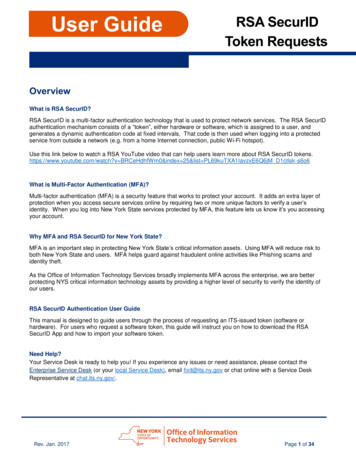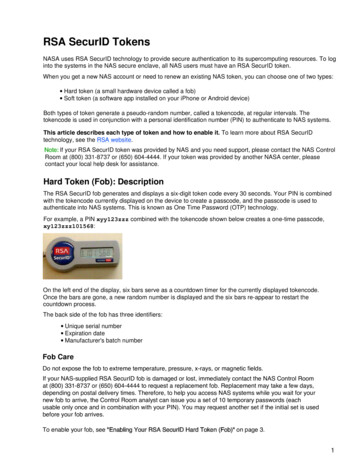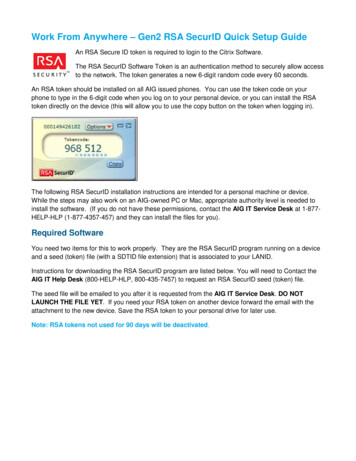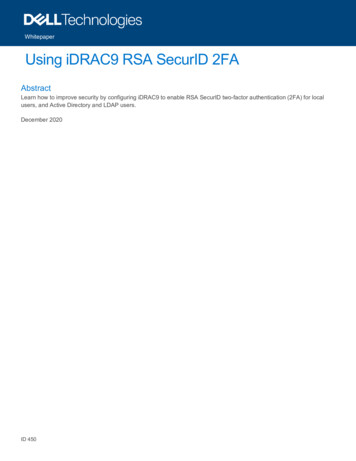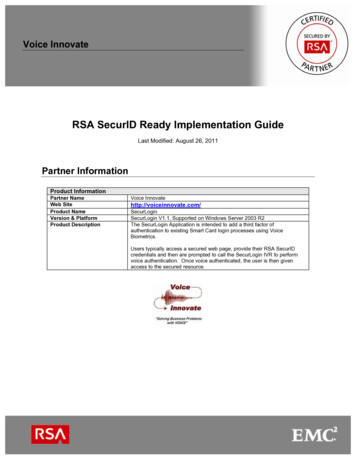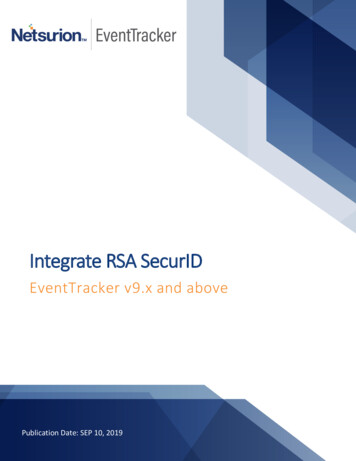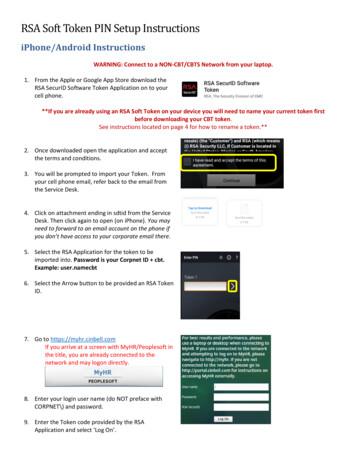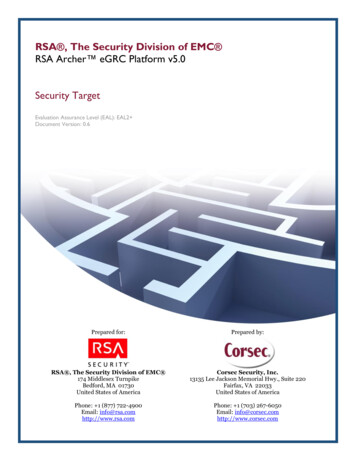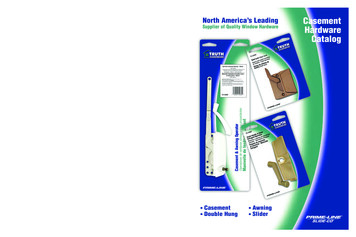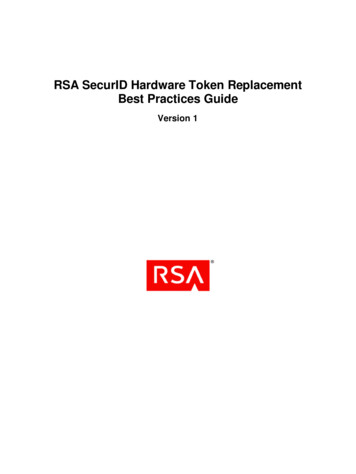
Transcription
RSA SecurID Hardware Token ReplacementBest Practices GuideVersion 1
Contact InformationGo to the RSA corporate web site for regional Customer Support telephone and fax numbers: www.rsa.com.TrademarksRSA, the RSA Logo and EMC are either registered trademarks or trademarks of EMC Corporation (“EMC”) in the UnitedStates and/or other countries. All other trademarks used herein are the property of their respective owners. For a list of RSAtrademarks, go to www.rsa.com/legal/trademarks list.pdf.License AgreementThe white paper and any part thereof is proprietary and confidential to EMC and is provided only for internal use bylicensee. Licensee may make copies only in accordance with such use and with the inclusion of the copyright notice below.The white paper and any copies thereof may not be provided or otherwise made available to any other person.No title to or ownership of the white paper or any intellectual property rights thereto is hereby transferred. Any unauthorizeduse or reproduction of the guide may be subject to civil and/or criminal liability.The white paper is subject to update without notice and should not be construed as a commitment by EMC.Note on Encryption TechnologiesThe referenced product may contain encryption technology. Many countries prohibit or restrict the use, import, or export ofencryption technologies, and current use, import, and export regulations should be followed when using, importing orexporting the referenced product.DistributionUse, copying, and distribution of any EMC software described in this publication requires an applicable software license.DisclaimerEMC does not make any commitment with respect to the software outside of the applicable license agreement.EMC believes the information in this publication is accurate as of its publication date. EMC disclaims any obligation toupdate after the date hereof. The information is subject to update without notice.THE INFORMATION IN THIS PUBLICATION IS PROVIDED TO SUGGEST BEST PRACTICES, IS PROVIDED "ASIS," AND SHALL NOT BE CONSIDERED PRODUCT DOCUMENTATION OR SPECIFICATIONS UNDER THETERMS OF ANY LICENSE OR SIMILAR AGREEMENT. EMC CORPORATION MAKES NO REPRESENTATIONSOR WARRANTIES OF ANY KIND WITH RESPECT TO THE INFORMATION IN THIS PUBLICATION, ANDSPECIFICALLY DISCLAIMS IMPLIED WARRANTIES OF MERCHANTABILITY OR FITNESS FOR APARTICULAR PURPOSE.All references to “EMC” shall mean EMC and its direct and indirect wholly-owned subsidiaries, includingRSA Security LLC.Copyright 2011 EMC Corporation. All Rights Reserved.November 2011
RSA SecurID Hardware Token Replacement Best Practices GuideCritical SectionsPlanning Considerations: Page 3RSA SecurID Token Replacement Approach: Page 7Testing: Page 9Restrictions and Limitations: Page 10IntroductionThis guide contains additional guidance for customers pursuing hardware token replacement. Thisguidance focuses on the planning and implementation approach for replacing a customer’s existingRSA SecurID hardware tokens with new RSA SecurID hardware tokens in the customer’senvironment.This guide is applicable to customer RSA SecurID implementations of all sizes using RSAAuthentication Manager 5.2, 6.1 or 7.1. However, the replacement procedures are generally intendedfor customers with relatively small user populations. Customers with large user populations mayrequire additional tools and assistance, which is available through RSA Professional Services. If youhave this type of user population, contact your RSA Account Manager for information about RSAProfessional Services.Note: This guide does not include guidance on conversion from RSA SecurID hardware tokens toRSA SecurID software tokens. Customers with this requirement should contact their RSA AccountManager about using RSA Professional Service in a separate services engagement.Planning ConsiderationsRSA strongly recommends that you carefully plan and test your token replacement strategy beforerolling it out within a production RSA SecurID environment due to the potential impacts on end-usersand the potential to undermine the security posture of the overall system.This planning should include a phased token distribution approach. This may include a prioritizationof targeted user populations and location of users, as well as communications to end-users to notifythem of the plan and to tell them what to expect.For a small number of token replacements, RSA recommends that you use the AuthenticationManager administrative interface to replace tokens one at a time. However, to replace large numbersof hardware tokens, RSA recommends that you use bulk administration tools or scripts. Whenassigning replacement tokens, RSA recommends that the current PIN be maintained on thereplacement token so that the token is not placed in New PIN mode. This simplifies the activation ofthe new token for the end-user.3
RSA SecurID Hardware Token Replacement Best Practices GuideRSA strongly recommends that you strengthen your PIN policy, but that you do so under a separateinitiative or engagement that does not overlap with the replacement of a user’s token. This is lessintrusive and less confusing for your end-users.Note: When replacing tokens, a new token can be associated with an existing token for a user. Atoken can be assigned for replacement days or weeks before a user actually receives the token, atwhich point they are instructed to, upon their next authentication, use their existing PIN followed bythe tokencode from the new replacement token. Once the user is successfully authenticated with thenew token, the old token will be automatically unassigned from their account and the newreplacement token activated.For information about PIN policy best practices, see the RSA Authentication Manager SecurityBest Practices Guide.Consider the following when planning your RSA SecurID hardware token replacement:1. Thoroughly review the target RSA SecurID environment to ensure a good understanding ofthe scope of the token replacement project, as well as possible tools required to complete thetasks.If the environment has a documented architecture, as well as documented processes (such asfor user enrollments, token renewals / replacements, etc.), use this as the basis of the review.If not, the current method for managing end-user tokens (new or replacement) should be wellunderstood and leveraged to minimize the impact on your environment and end-users.2. Determine which users in the environment require token replacement. Many environmentshave multiple token types, but the approach in this guide is for hardware tokens only. TheAuthentication Manager reporting tools or scripts can help identify these users.3. Determining which users should receive hardware token replacements will likely be subject toa variety of policy and other business requirements and should therefore be carefully plannedout. RSA recommends that users with the most privileges, especially those responsible foradministering the Authentication Manager environment or other sensitive systems, be givenhighest priority.It may also be desirable or necessary to further split users into manageable groups especiallyif tokens are typically distributed regionally.Use the following table to assist with the creation of a prioritized token replacement strategy:4
RSA SecurID Hardware Token Replacement Best Practices GuideUser GroupingUserClassificationHigh PrivilegeRSA Token UsersRSA AdminsPrivilegedNotesRSA Authentication Manager system administrators withthe permissions for system configuration, tokendistribution, and so on. In Authentication Manager 6.1these are users assigned one or more administrative“Task Lists”; in Authentication Manager 7.1 these areusers assigned at least one “Administrative Role”.Users with some ability to manage tokens or users, butrestricted in some fashion from broader access, forexample, help desk personnelExternal AdminsPrivilegedUsers with administrative permissions to RSA agentprotected infrastructure, such as servers, firewalls,switches, VPN concentrators, and so on, but not RSAAuthentication Manager administratorsAgent ProtectedApplicationConsumersSpecialUsers with access to restricted agents or groups mostlikely users accessing enterprise applications, such asPCI systems, HR, and so on.StandardUsers that use tokens to authenticate to unrestrictedapplications or for infrastructure access. These usershave no special permissions in RSA AuthenticationManager or other systems other than being required touse tokens for authentication.Token End-UsersNote: This table is a general guideline only. You may need to establish other prioritizationcriteria in accordance with your organization’s business requirements, existing policies andprocedures, communication plans or mechanisms and any applicable legal, regulatory and/orcompliance regimes.4. Determine the best RSA SecurID hardware token distribution mechanism. Factors that mayaffect this decision are: Current distribution methods – Leveraging a current distribution method, which isfamiliar within an environment, is generally easier to implement and can often avoidconfusion. The security of the current distribution method – Ensuring that the proper RSA SecurIDtoken is distributed to the proper user. Location of end-users - Determine whether users are in a single office location or remoteoffices.If tokens must be shipped to remote locations and offices, be careful to use accurate shippingaddresses to ensure the correct token is delivered to the correct user at the most securelocation possible.5
RSA SecurID Hardware Token Replacement Best Practices Guide5. Your replacement plan must also take into consideration the number of hardware tokens to bereplaced. Organizations with large numbers of tokens to be replaced may not have thecapacity to store or distribute all tokens in a single phase. In these situations a phasedapproach and roll out plan may need to be developed.6. A communication plan, particularly in large environments, is necessary to inform end-users ofthe replacement plan and how it will be implemented. This helps to set the correctexpectations regarding process and timelines. Every organization has its own employeecommunications mechanism and standards which should be utilized.It is especially important to inform the end-users of how to activate their new tokens whenthey receive them and the need for them to do so as soon as possible. You should also giveguidance to end-users to protect against social engineering or other ways in which fraudstersmay attempt to subvert or co-opt the process. Advise end-users to alert the proper authoritiesof any suspicious behavior. Combining such messaging reinforces the importance of the endusers’ role in the process. For guidance on preventing social engineering attacks, see theRSA Authentication Manager Security Best Practices Guide.7. Once the token replacement process is initiated, you should have a plan to: Track the progress of the tokens being replaced. If there is too much time between thedelivery of a new token and the activation of the token, then you should contact end-usersto ensure replacements have not fallen into the wrong hands. Proper reporting andauditing procedures should be established to assist with managing the process withoutover complicating it. Proper and clear communication of end-user expectations andresponsibilities, as described above, can help ensure the process goes as smoothly andquickly as possible. Remove the old token from the Authentication Manager database once a new token hasbeen successfully activated and the old token is unassigned. Dispose of old tokens. Provide guidance to end-users on what to do with their old tokensonce the new ones are activated. Ideally, an organization will have a token disposalprocedure in place already. If not, however, consideration should be given to creating oneand communicating the details to the end-users stressing the importance of properdisposal.The following link is RSA’s statement on disposal of RSA SecurID tokens which can beincorporated as part of the customer overall disposal plan:http://www.rsa.com/support/pdfs/Token Disposal statement.pdf6
RSA SecurID Hardware Token Replacement Best Practices GuideRSA SecurID Token Replacement ApproachSecurID Token Replacement Using Administrative InterfaceAs mentioned earlier in this document, for a relatively low number of token replacements, RSArecommends that you use the Authentication Manager administrative interface to replace tokens oneat a time. This is the high-level process for token replacement for Authentication Manager 7.1, 6.1and 5.2 using the administrative interface:1. Logon to the Authentication Manager administrative interface: For Authentication Manager 6.1 and 5.2 this is through Quick Admin or the RemoteDesktop Client. For Authentication Manager 7.1 this is through the Security Console.2. Import new seed records into the Authentication Manager Primary server.3. Look up the specific user whose token you want to replace and identify the current tokenassigned to that user.4. Note the assigned RSA SecurID token, and proceed to edit the currently assigned RSASecurID Token to associate a new replacement RSA SecurID Token. This functionalitypermits the automated replacement through a user initiated authentication.5. Repeat for every user that requires a replacement RSA SecurID Token.6. Validate in the Authentication Manager administrative interface that the operations weresuccessful.7. Create a report of users with their assigned replacement tokens for distribution purposes.8. Execute your communication plan to inform users and to set expectations.9. Distribute tokens to the correct users in a secure manner that is convenient for theorganization.10. Users perform an authentication (login) to an RSA agent using the newly assigned token. TheLogin is performed with normal passcode (current PIN tokencode from new token).7
RSA SecurID Hardware Token Replacement Best Practices Guide11. The original token is replaced by a new (replacement) token. Original token is unassigned from user. Original token may be deleted from database simultaneously. Same PIN is maintained on the replacement token.Note: For information about PIN policy best practices, see the RSA AuthenticationManager Security Best Practices Guide.12. Run reports on regular intervals to ensure token replacements occur within days of receipt. Iftoken replacements are taking too long, disable the user’s account or existing token forcingthem to contact an administrator or appropriate help desk personnel.Detailed steps for token replacement for Authentication Manager 7.1 5.2 and 6.1 can be found inAppendix A and Appendix B respectively.RSA SecurID Token Replacement Using Bulk ScriptingWhen replacing large numbers of hardware tokens, RSA recommends that you use bulkadministration tools or scripts. This is the high-level process for token replacement for AuthenticationManager 7.1, 6.1 and 5.2 using scripts:1. Import new seed records into the Authentication Manager Primary server.2. Install the appropriate scripts on the Authentication Manager primary server.3. Use the reporting capabilities of each platform to identify users and physical tokens that mustbe replaced at each location.4. Generate a list of token serial numbers and associated users for which tokens are beingreplaced in accordance with your token replacement strategy.5. Generate a list of replacement token serial numbers (attempt to group by box/tray of tokens tofacilitate distribution).6. Create a coma separated values (.csv) input file for the associate scripts in the requiredformat.7. Run scripts to replace tokens for list of users.Note: You should test the scripts and input files in a test environment to make sure theyachieve the desired results.8. Manually validate in the Authentication Manager administrative interface that the operationwas successful.9. Destroy copies of the .csv files and Excel files used to create the replacement loader file.10. Create a report of users with their assigned replacement tokens for distribution purposes.11. Execute your communication plan to inform users and to set expectations.8
RSA SecurID Hardware Token Replacement Best Practices Guide12. Distribute tokens to the correct users in a secure manner that is convenient for theorganization.13. User performs an authentication (login) to an RSA agent using the newly assigned token; theLogin is performed with normal passcode (current PIN tokencode from new token).14. The original token is replaced by a new (replacement) token. Original token is unassigned from user. Original token may be deleted from database simultaneously. Same PIN is maintained on the replacement token.Note: For information about PIN policy best practices, see the RSA AuthenticationManager Security Best Practices Guide.15. Run reports on regular intervals to ensure token replacements occur within days of receipt. Iftoken replacements are taking too long, disable the user’s account or existing token forcingthem to contact an administrator or appropriate help desk personnel.16. Destroy all copies of the CSV files, Excel files, and user and token lists used for the tokenreplacement activity.The token replacement scripts will vary slightly depending if the customer’s environment isAuthentication Manager 7.1 or Authentication Manager 6.1 (and prior). Detailed steps for tokenreplacement on Authentication Manager 7.1, 6.1 and 5.2 using scripts can be found at Appendix Cand Appendix D respectively.For more information about bulk administration tools, contact your Sales Representative.TestingThe following are essential test considerations: Tokens and seed records utilized in the test environment should not be re-used in productionafter the testing phase. Scripts and tools, if utilized, for performing bulk operations should always be tested in adevelopment or test environment which replicates the production environment as much aspossible. When applying the token replacement solution to the production environment, apply to asmaller group of pilot users before applying to the larger user population. Testing should include scenarios for at least the following tasks: End-user token activation procedure(s). If utilized, testing the token import scripts and input files. Validating scripts for generating user and token assignment reports.9
RSA SecurID Hardware Token Replacement Best Practices GuideRestrictions and LimitationsAll guidance and information set forth in this white paper and any other documents, including,without limitation, guidance and other information published in the Best Practices Guides, regardingthe creation of a phased and prioritized hardware token replacement strategy is general guidance andis provided “as is” and EMC makes no representations or warranties of any kind with respect to theinformation in this white paper and specifically disclaims implied warranties of merchantability orfitness for a particular purpose.RSA strongly recommends that each organization’s actual plan be established in accordance with itsbusiness requirements, existing policies and procedures, communication plans or mechanisms and anyapplicable regulatory compliance regimes.10
RSA SecurID Hardware Token Replacement Best Practices GuideAppendix A: RSA Authentication Manager 7.1 Token ReplacementUsing Security ConsoleOverviewThis appendix describes the process for replacing hardware tokens in Authentication Manager 7.1.The “Replace SecurID Token” functionality is designed for replacing an existing hardware token witha new token where the end-user’s PIN is retained.To activate a replacement token, the end-user must authenticate with the new token at which point theAuthentication Manager server unassigns and disables or deletes the old token from the database andassigns the existing PIN to the new token.Using the “Replace SecurID Token” option is the recommended method for issuing new tokens tousers due to the superior end-user experience while also reducing administrative activity, such asassigning end-users new tokens and manually disabling the old token. Software or hardware tokenscan be used to replace existing software or hardware tokens in the system. This guidance is forreplacing RSA SecurID hardware tokens with new RSA SecurID hardware tokens only.There are two separate options when using “Replace SecurID Token”: replacing a token by manually selecting a specific token from a list of available tokens; or replacing a token with the next available token from the pool of available tokens.The “next available” replacement process is only suitable for customers with a limited number oftokens distributed from a central location since the automatic selection process randomly selects thenext unassigned token with the lowest serial number.For hardware tokens this requires the exact token to be located and retrieved from the correct tray oftokens. It may also have the additional effect of assigning a different RSA SecurID token type, forexample, an RSA SecurID Software Token, which may not be the desired result. RSA recommendsthe manual selection option described below.Token Replacement Process – Manually Selected TokenThe following instructions describe how to assign a replacement token from a searchable list ofavailable, unassigned tokens. It is best suited for assigning replacement hardware “fob” tokens,especially if tokens are issued or shipped from multiple locations, or where software and hardwaretokens are deployed.This process affords the best control over assigning replacements so the administrator can make theappropriate choice based on their business and/or logistical requirements.11
RSA SecurID Hardware Token Replacement Best Practices GuideTo replace an RSA SecurID hardware token with a selected RSA SecurID hardware token:1. Log on to the RSA Security Console.2. Lookup the user and then token. Click Identity Users Manage Existing.Figure 1- User Lookup3. Select the correct Identity Source.Figure 2- Select Identity Source4. By default the UI searches on last name. Optionally pick a different user attribute from the listif desired. For example, you can pick User ID.Figure 3- User Search Attribute Screen12
RSA SecurID Hardware Token Replacement Best Practices Guide5. Enter identifying user information in the search box and execute the search for the user.Figure 4- User Search6. Click themenu icon next to the UserID and select SecurID Tokens from the menu.Figure 5- User Context Menu13
RSA SecurID Hardware Token Replacement Best Practices Guide7. The tokens assigned to the user will be listed.Figure 6- List of tokens assigned to user8. Make note of the token serial number to be replaced.Figure 7 - Making Note of the token serial number14
RSA SecurID Hardware Token Replacement Best Practices Guide9. Click Authentication SecurID Tokens Manage Existing.Figure 8- Manage Existing RSA SecurID Tokens10. Enter the recorded serial number, and if necessary, select the correct security domain from thedrop-down list and click Search.Figure 9- Search for Chosen Token to be a Replacement11. Select the token to be replacedFigure 10- Select the Token to Be Replaced15
RSA SecurID Hardware Token Replacement Best Practices Guide12. From the Action menu, select Replace SecurID Tokens, and click Go.Figure 11- Select Replace SecurID Tokens From Action Menu13. Select an RSA SecurID hardware token from the tray and enter the serial number in thesearch dialog.Figure 12- Enter Serial Number of New Token16
RSA SecurID Hardware Token Replacement Best Practices Guide14. Select the token and click Next.Figure 13- Select the Chosen Replacement Token17
RSA SecurID Hardware Token Replacement Best Practices Guide15. Click Save & Finish to complete the hardware token replacement.Figure 14- Confirm the Replacement16. The selected hardware token has now been activated as a replacement.Figure 15- Hardware Token as Replacement CompleteThis is the end of the hardware token replacement process. You must repeat this process for eachtoken that is being replaced.18
RSA SecurID Hardware Token Replacement Best Practices GuideAppendix B: RSA Authentication Manager 5.2 and 6.1 TokenReplacement Using Administrative InterfaceOverviewThis document describes the manual process for replacing hardware tokens in AuthenticationManager 5.2 and6.1. The “Assign Replacement Token” functionality is designed for replacing anexisting token with a new token where the user’s PIN is retained. To activate a replacement token, theend-user must authenticate with the new token. After a successful authentication, AuthenticationManager unassigns and disables or deletes the old token from the database, and assigns the existingPIN to the new token.Using the “Assign Replacement Token” option is the recommended method for issuing new tokens tousers due to the superior end-user experience while also reducing administrative activity, such asassigning users new tokens and manually disabling the old token. Software or hardware tokens can beused to replace existing software or hardware tokens in the system. This guidance is for replacinghardware tokens with new hardware tokens only.Token Replacement Process – Manually Selected TokenTo replace an RSA SecurID hardware token with a selected RSA SecurID Hardware token:1. Log on to Authentication Manager through Quick Admin or the Database Administrationapplication in remote mode.2. Click System Configuration System Parameters Token, PIN and PasswordParameters. If not already selected, select Automatically delete replaced tokens fromdatabase. Selecting this option completely removes the replaced token from the databaseafter a successful authentication with the replacement token.19
RSA SecurID Hardware Token Replacement Best Practices GuideFigure 16- Enable Automatic Delete of Replaced Token Screen3. Lookup user and then token. Click User Edit User.Figure 17- User Lookup4. Select a user. You can search for a user by First name, Last name or Default Login (UserID).20
RSA SecurID Hardware Token Replacement Best Practices GuideFigure 18- User Search Page21
RSA SecurID Hardware Token Replacement Best Practices Guide5. Once the user is selected, a page displays with the user’s information. This page containsinformation about the user’s current token and administrative actions that can be performedagainst the token.Figure 19- User Token Information Page6. Click Edit Assigned Token.Figure 20- Edit Assigned Token Option22
RSA SecurID Hardware Token Replacement Best Practices Guide7. Click Assign Replacement Token.Figure 21- Assign Replacement Token Screen8. Enter replacement token serial number or click Tokens to list available tokens. Ensure RetainPINs from token to be replaced is selected.Figure 22- Entering Token Serial number on ‘Select Replacement Token’ Screen23
RSA SecurID Hardware Token Replacement Best Practices GuideFigure 23- Listing Available Tokens on ‘Select Replacement Token’ Screen9. The screen will display information about the token and additional actions that can beperformed against the token. It will also list the replacement token information.24
RSA SecurID Hardware Token Replacement Best Practices GuideFigure 24- Replacement Token Information Page10. Click OK to accept all changes. The next screen provides a confirmation that the replacementtoken has been assigned to the user.Figure 25- Successful Token Replacement Dialog box25
RSA SecurID Hardware Token Replacement Best Practices GuideVerify Replacement TokensTo verify the replacement token has been assigned to the user:1. Lookup the user and token. Click User Edit User.2. In the ‘Tokens’ section, look for ‘R’ next to the serial number of the token recently assigned.This verifies that the user now has a replacement token.Figure 26- Replacement token verification screen3. Click OK.26
RSA SecurID Hardware Token Replacement Best Practices GuideAppendix C: RSA Authentication Manager 7.1 Token ReplacementUsing ScriptsOverviewThe Authentication Manager 7.1 Software Development Kit (SDK) can be used to replace or modifylarge quantities of RSA SecurID information, such as tokens in a customer environment. TheAuthentication Manager 7.1 SDK supplements administrative features of the Authentication Manager7.1 Security Console, and enables RSA SecurID administrators to perform bulk administrationfunctions through java utilities from the command line interface or in a background mode through ascheduled script.For more information on the proper use of Authentication Manager 7.1 SDK, see theRSA Authentication Manager 7.1 Developer's Guide.There is no completely Java-based scripting solution for Authentication Manager 7.1 requiring JARfiles to be compiled before they can be executed on the platform, however, support for Jython, aPython /Java derivative, is included and can provide for run-time script execution. Essentially, Jythonscripts are hybrid Java applications that are executed without the need for compilation into Javabytecode.To replace a small number of tokens, RSA recommends using the Authentication Manager 7.1Security Console to manually replace tokens. To replace a large number of tokens, RSA recommendsthat you use automation tools to bulk assign replacement tokens. This can be accomplished by a Javadeveloper familiar with the Authentication Manager 7.1 SDK, or by a developer who writes a Jythonscript. When assigning replacement tokens, RSA recommends that the current PIN be maintained onthe replacement token so that the token is not placed in New PIN mode.Note: For information about PIN policy best practices, see the RSA Authentication ManagerSecurity Best Practices Guide.To facilitate bulk token replacements a Jython script has been included below.The following is a high level overview of the process: Run a script to assign replacement tokens. The user performs a login with replaceme
RSA Admins High Privilege. RSA Authentication Manager system administrators with the permissions for system configuration, token distribution, and so on . In Authentication Manager 6.1 these are users assigned one or more administrative “Task Lists”; in Authentication Manager 7.1 the
